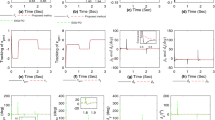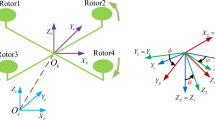Abstract
This work investigates the attitude control of reentry vehicle under modeling inaccuracies and external disturbances. A robust adaptive fuzzy PID-type sliding mode control (AFPID-SMC) is designed with the utilization of radial basis function (RBF) neural network. In order to improve the transient performance and ensure small steady state tracking error, the gain parameters of PID-type sliding mode manifold are adjusted online by using adaptive fuzzy logic system (FLS). Additionally, the designed new adaptive law can ensure that the closed-loop system is asymptotically stable. Meanwhile, the problem of the actuator saturation, caused by integral term of sliding mode manifold, is avoided even under large initial tracking error. Furthermore, to eliminate the need of a priori knowledge of the disturbance upper bound, RBF neural network observer is used to estimate the disturbance information. The stability of the closed-loop system is proved via Lyapunov direct approach. Finally, the numerical simulations verify that the proposed controller is better than conventional PID-type SMC in terms of improving the transient performance and robustness.
Similar content being viewed by others
References
H. J. Xun, M. D. Mirmirani, and P. A. Ioannou, “Adaptive sliding mode control design for a hypersonic flight vehicle,” Journal of Guidance, Control, and Dynamics, vol. 27, no. 5, pp. 829–838, 2004.
J. Geng, Y. Z. Sheng, and X. D. Liu, “Finite-time sliding mode attitude control for a reentry vehicle with blended serodynamic surfaces and a reaction control system,” Chinese Journal of Aeronautics, vol. 27, no. 4, pp. 964–976, 2014.
Q. Wang and R. F. Stengel, “Robust nonlinear control of a hypersonic aircraft,” Journal of Guidance, Control, and Dynamics, vol. 23, no. 4, pp. 577–585, 2000.
H. Huang and Z. Zhang, “Characteristic model-based H2/H robust adaptive control during the re-entry of hypersonic cruise vehicles,” Science China Information Sciences, vol. 58, no. 1, pp. 1–21, January 2015.
Y. Shtessel, J. McDuffie, M. Jackson, and C. Hall, “Sliding mode control of the X-33 vehicle in launch and reentry modes,” Report No.: AIAA-1998-4414, 1998.
Y. Shtessel, C. Hall, and M. Jackson, “Reusable launch vehicle control in multiple-time-scale sliding modes,” J Guid Control Dyn, vol. 23, no. 6, pp. 1013–1020, 2000.
T. L. Chung and T. H. Bui, “Sliding mode control of twowheeled welding mobile robot for tracking smooth curved welding path,” KSME International Journal, vol. 18, no. 7, pp. 1094–1106, 2004.
N. Hung, T. D. Viet, J. S. Im, and H. K. Kim, “Motion control of an omnidirectional mobile platform for trajectory tracking using an integral sliding mode controller,” International Journal of Control, Automation, and Systems, vol. 8, no. 6, pp. 1221–1231, 2010.
V. Utkin and J. Shi, “Integral sliding mode in systems operating under uncertainty conditions,” Proc. of the 35th IEEE Conference on Decision and Control, pp. 4591–4596, 1996.
Q. Zong, J. Wang, and B. L. Tian, “Quasi-continuous highorder sliding mode controller and observer design for flexible hypersonic vehicle,” Aerospace Science and Technology, vol. 27, no. 1, pp. 127–137, 2013.
X. X. Hu, L. G. Wu, C. H. Hu, and H. J. Gao, “Adaptive sliding mdoe tracking control for a flexible air-breathing hypersonic vehicle,” Journal of The Franklin Institute, vol. 349, no. 2, pp. 559–577, March 2012
J. Slotine, “Sliding mode controller design for nonlinear system,” International Journal of Control, vol. 40, no. 2, pp. 421–434, 1984.
J. Slotine and S. Sastry, “Tracking control of nonlinear systems using sliding surfaces with application to robot manipulator,” International Journal of Control, vol. 38, no. 2, pp. 465–492, 1983.
T. L. Chern and Y. C. Wu, “Design of integral variable structure controller and application to electronic hydraulic velocity servos systems,” IEEE Proceedings D Control Theory and Applications, vol. 138, no. 5, pp. 439–444, 1991.
Y. M. Li and Q. S. Xu, “Adaptive sliding mode control with perturbation estimation and PID sliding surface for motion tracking of a piezo-driven micromanipulator,” IEEE Transactions on Control Systems Technology, vol. 18, no. 4, pp. 798–810, July 2010.
D. Cho, Y. Kato, and D. Spliman, “Sliding mode and classical controller in magnetic levitation systems,” IEEE Control System Magazine, vol. 13, no. 1, pp. 42–48, 1993.
S. Seshagiri and H. Khalil, “On introducing integral action in sliding mode control,” Proc. of the 41th IEEE Conference on Decion and Control, Las Vegas, Nevada, USA, 2002.
F. Plestan, Y. Shtessel, V. Bregeault, and A. Poznyak. “New methodologies for adaptive sliding mode control,” International Journal of Control, vol. 83, no. 9, pp. 1907–1919, 2010.
Y. Shtessel, I. Shkolnikov, and A. Levant, “Smooth secondorder sliding modes: Missile guidance application,” Automatic, vol. 43, no. 7, pp. 1470–1480, 2007.
P. L. Lu, C. Gan, and X. D. Liu, “Finite time distributed cooperative attitude control for multiple spacecraft with actuator saturation,” IET Control Theory and Applications, vol. 8, no. 18, pp. 2186–2198, 2014.
H. Morioka, K. Wada, and A. Sabanovic, “Neural network based chattering free sliding mode control,” Proc. of the 34th SICE Annual Conference, pp. 1303–1308, 1995.
D. Munoz and D. Sbarbaro, “An adaptive sliding mode controller for a discrete nonlinear system,” IEEE Transactions on Industrial Electronics, vol. 47, no. 3, pp. 574-481, 2000.
S. J. Huang, K. S. Huang, and K. C. Chiou, “Development and application of a novel radial basis function sliding mode controller,” Mechatronics, vol. 13, no. 3, pp. 313–329, 2003.
Z. Y. Zhao, M. Tomizuka, and S. Isaka, “Fuzzy gain scheduling of PID controllers,” IEEE Transactions on Systems, vol. 23, no. 5, pp. 1392–1398, 1993.
W. V. Soest, Q. Chu, and J. Mulder, “Combined feedback linearization an constrained model predictive control for entry,” Journal of Guidance, Control, and Dynamics, vol. 29, no. 2, pp. 427–434, 2006.
H. B. Sun, S. H. Li, and C. Y. Sun, “Finite time integral sliding mode control of hypersonicvehicles,” Nonlinear Dyn., vol. 73, no. 1, pp. 229244, 2013.
Y. Stepanenko and Y. Cao, “Variable structure control of robotic manipulator with PID sliding surfaces,” International Journal of Robust and Nonlinear Control, vol. 8, no. 1, pp. 79–90, 1998.
Z. A. Min and K. D. Kumar, “Adaptive fuzzy fault-tolerant attitude control of spacecraft,” Control Engineering Practice, vol. 19, no. 1, pp. 10–21, 2011.
L. X. Wang, Adaptive Fuzzy System and Control: Design and Stability Analysis, Prentice Hall, Englewood Cliffs, NJ, 1994.
H. K. Khalil, Nonlinear System, Vol. 3, Prentice Hall, Upper Saddle River, 2002.
Z. Qu, Robust Control of Nonlinear Uncertain Systems, Wiley, New York, 1998.
I. Eker, “Second-order sliding mode control with experimental application,” ISA Transactions, vol. 49, no. 3, pp. 394–405, 2010.
J. Shaughnessy, S. Pinckney, and J. McMinn, “Hypersonic vehicle simulation model: winged-cone configuration,” NASA Technical Memorandum 102610, November 1990.
Author information
Authors and Affiliations
Corresponding author
Additional information
Recommended by Associate Editor Yingmin Jia under the direction of Editor Euntai Kim. This work is supported by National Natural Science Foundation of China under grant 11402020 and 11372034, Innovative Research Team of Beijing Institute of Technology.
Zhen Jin received the B.S. degree in Control Science and Engineering from Beijing University of Chemistry Technology (BUCT) in 2013. He is now a M.S. candidate at the School of Automation at BIT. His research interests include nonlinear control, adaptive control, sliding mode control.
Jiabin Chen received his Ph.D. degrees from Shanghai Jiaotong University in 1992. He is currently a professor with the School of Automation in BIT. His research interests include high-precision servo control, spacecraft attitude control.
Yongzhi Sheng received his B.S. and M.S. degrees from Beihang University, in 2003 and 2006, respectively, and his Ph.D. degree from the Graduate School of the Second Academy of China Aero-space in 2009. From 2009 to 2011 he did his post doctor research in Beihang Uni-versity. He is currently a lecturer with BIT. His research interests include guid-ance and control design of reentry vehicle.
Xiangdong Liu received his M.S. and Ph.D. degrees from Harbin Institute of Technology (HIT), in 1992 and 1995, respectively. From 1998 to 2000, he did his post doctor research in mechanical postdoctoral research center in HIT. He is currently a professor with the School of Automation in BIT. His research interests include high-precision servo control, spacecraft attitude control, chaos theory.
Rights and permissions
About this article
Cite this article
Jin, Z., Chen, J., Sheng, Y. et al. Neural network based adaptive fuzzy PID-type sliding mode attitude control for a reentry vehicle. Int. J. Control Autom. Syst. 15, 404–415 (2017). https://doi.org/10.1007/s12555-015-0181-1
Received:
Revised:
Accepted:
Published:
Issue Date:
DOI: https://doi.org/10.1007/s12555-015-0181-1




